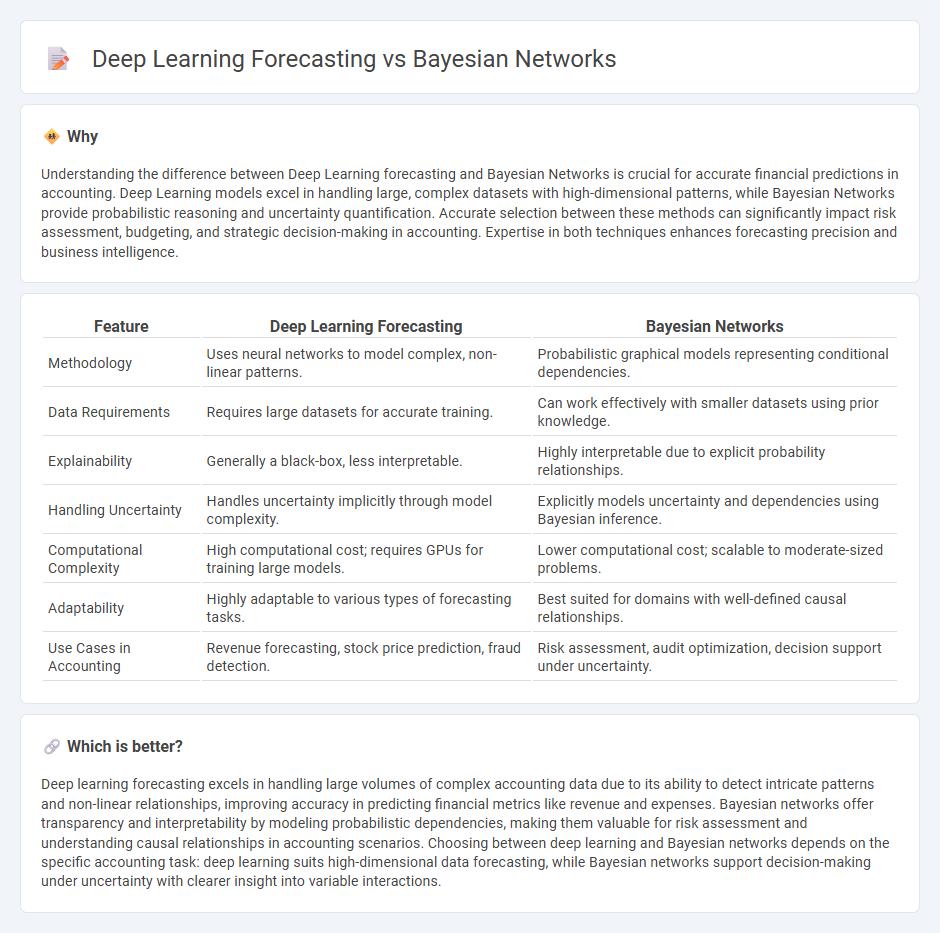
Deep learning forecasting utilizes neural networks to analyze vast datasets, capturing complex, nonlinear patterns for highly accurate predictions in accounting. Bayesian networks model probabilistic relationships among variables, enabling transparent uncertainty quantification and decision-making in financial analysis. Explore the strengths and applications of these advanced techniques to enhance your accounting forecasts.
Why it is important
Understanding the difference between Deep Learning forecasting and Bayesian Networks is crucial for accurate financial predictions in accounting. Deep Learning models excel in handling large, complex datasets with high-dimensional patterns, while Bayesian Networks provide probabilistic reasoning and uncertainty quantification. Accurate selection between these methods can significantly impact risk assessment, budgeting, and strategic decision-making in accounting. Expertise in both techniques enhances forecasting precision and business intelligence.
Comparison Table
| Feature | Deep Learning Forecasting | Bayesian Networks |
|---|---|---|
| Methodology | Uses neural networks to model complex, non-linear patterns. | Probabilistic graphical models representing conditional dependencies. |
| Data Requirements | Requires large datasets for accurate training. | Can work effectively with smaller datasets using prior knowledge. |
| Explainability | Generally a black-box, less interpretable. | Highly interpretable due to explicit probability relationships. |
| Handling Uncertainty | Handles uncertainty implicitly through model complexity. | Explicitly models uncertainty and dependencies using Bayesian inference. |
| Computational Complexity | High computational cost; requires GPUs for training large models. | Lower computational cost; scalable to moderate-sized problems. |
| Adaptability | Highly adaptable to various types of forecasting tasks. | Best suited for domains with well-defined causal relationships. |
| Use Cases in Accounting | Revenue forecasting, stock price prediction, fraud detection. | Risk assessment, audit optimization, decision support under uncertainty. |
Which is better?
Deep learning forecasting excels in handling large volumes of complex accounting data due to its ability to detect intricate patterns and non-linear relationships, improving accuracy in predicting financial metrics like revenue and expenses. Bayesian networks offer transparency and interpretability by modeling probabilistic dependencies, making them valuable for risk assessment and understanding causal relationships in accounting scenarios. Choosing between deep learning and Bayesian networks depends on the specific accounting task: deep learning suits high-dimensional data forecasting, while Bayesian networks support decision-making under uncertainty with clearer insight into variable interactions.
Connection
Deep learning forecasting enhances accounting accuracy by analyzing complex financial data patterns to predict future trends, while Bayesian networks model probabilistic relationships among accounting variables, improving risk assessment and decision-making. Integrating deep learning with Bayesian networks enables robust uncertainty quantification and dynamic updating of forecasts based on new financial information. This synergy supports more precise budgeting, fraud detection, and financial planning in accounting practices.
Key Terms
Probabilistic Inference
Bayesian networks excel in probabilistic inference by modeling dependencies among variables using directed acyclic graphs, enabling transparent uncertainty quantification in forecasting. Deep learning forecasting leverages layered neural architectures to capture complex, nonlinear patterns but often lacks explicit probabilistic reasoning and interpretability. Explore how integrating Bayesian inference with deep learning can enhance predictive accuracy and uncertainty handling in advanced forecasting models.
Neural Networks
Bayesian networks leverage probabilistic graphical models to represent dependencies among variables, enabling interpretable inference and uncertainty quantification in forecasting tasks. Deep learning, particularly neural networks, excels at capturing complex, non-linear relationships in large datasets through layered architectures like CNNs and RNNs, often achieving superior predictive accuracy but with less transparency. Explore the strengths and trade-offs between Bayesian networks and neural network-based deep learning to enhance your forecasting strategy.
Model Interpretability
Bayesian networks provide transparent probabilistic models that clearly show variable relationships and causal dependencies, enhancing interpretability in forecasting tasks. Deep learning models, while powerful in handling complex, high-dimensional data, often function as opaque "black boxes" with limited insight into their decision-making processes. Explore the detailed comparison of model interpretability to choose the best forecasting approach for your needs.
Source and External Links
Bayesian Network - A Bayesian network is a probabilistic graphical model used for representing relationships among variables and performing probabilistic inference tasks.
Introduction to Bayesian Networks - Bayesian networks are a type of probabilistic graphical model that can be used for various tasks including diagnostics, reasoning, and decision-making under uncertainty.
Bayesian Networks in Radiology - Bayesian networks are employed in radiology to integrate clinical and imaging findings for diagnosis and clinical decision-making, utilizing probability theory to represent variable relationships.
 dowidth.com
dowidth.com